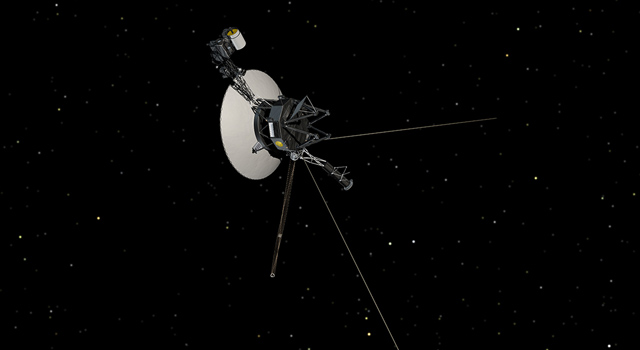News | May 26, 1993
Voyager 1 & 2 Discovers Evidence of the Heliopause

Nearly 15 years after they left home, the Voyager 1 and 2 spacecraft have discovered the first direct evidence of the long-sought-after heliopause -- the boundary that separates Earth's solar system from interstellar space.
"This discovery is an exciting indication that still more discoveries and surprises lie ahead for the Voyagers as they continue their journey to the outer reaches of our solar system," said Dr. Edward C. Stone, director of the Jet Propulsion Laboratory and Voyager project scientist.
Since August 1992, the radio antennas on the spacecraft, called the plasma wave subsystem, have been recording intense low frequency radio emissions coming from beyond the solar system. For months the source of these radio emissions remained a mystery.
"Our interpretation now is that these radio signals are created as a cloud of electrically charged gas, called a plasma, expands from the sun and interacts with the cold interstellar gas beyond the heliopause," said Dr. Don Gurnett, principal investigator of the Voyager plasma wave subsystem and a professor at the University of Iowa.
The sun is the center of our solar system. The solar wind is a stream of electrically charged particles that flows steadily away from the sun. As the solar wind moves out into space, it creates a magnetized bubble of hot plasma around the sun, called the heliosphere. Eventually, the expanding solar wind encounters the charged particles and magnetic field in the interstellar gas. The boundary created between the solar wind and interstellar gas is the heliopause.
"These radio emissions are probably the most powerful radio source in our solar system," said Gurnett. "We've estimated the total power radiated by the signals to be more than 10 trillion watts. However, these radio signals are at such low frequencies, only 2 to 3 kilohertz, that they can't be detected from Earth."
In May and June 1992, the sun experienced a period of intense solar activity which emitted a cloud of rapidly moving charged particles. When this cloud of plasma arrived at the heliopause, the particles interacted violently with the interstellar plasma and produced the radio emissions, according to Gurnett.
"We've seen the frequency of these radio emissions rise over time. Our assumption that this is the heliopause is based on the fact that there is no other known structure out there that could be causing these signals," Gurnett continued.
Because of the Voyagers' unique positions in space, they serendipitously detected and recorded the radio emissions. "Earth-bound scientists would not know this phenomenon was occurring if it weren't for the Voyager spacecraft," Gurnett added.
Exactly where the heliopause is remains one of the great unanswered questions in space physics.
"It's this Voyager radio data combined with the plasma measurements taken at the spacecraft that give us a better guess about where the heliopause is. Based on the solar wind speed, the time that has elapsed since the mid-1992 solar event and the strength of the radio emissions, my best guess for the upper limit of the heliopause currently is about 90 to 120 astronomical units (AU) from the sun," said Dr. Ralph McNutt, a co-investigator on the Voyager plasma science experiment and a researcher at the Johns Hopkins University Applied Physics Laboratory in Laurel, Md. (One AU is equal to 150 million kilometers (93 million miles) or the mean distance from Earth to the sun.)
Voyager 1 currently is at 52 AU (7.8 billion kilometers or 4.9 billion miles from the sun), and Voyager 2 is at 40 AU (6 billion kilometers or 3.7 billion miles) from the sun.
Voyager 1 was launched on Sept. 5, 1977 and completed flyby exploration of both Jupiter and Saturn. The spacecraft now is rising above the ecliptic plane -- the plane in which most of the planets orbit the sun -- at an angle of about 35 degrees at a rate of about 520 million kilometers (about 320 million miles) a year.
Voyager 2 was launched on Aug. 20, 1977 and also completed visits to Jupiter and Saturn and then went on to explore Uranus and Neptune, completing the reconnaissance of the giant outer planets. The spacecraft is now diving below the ecliptic plane at an angle of about 48 degrees and a rate of about 470 million kilometers (about 290 million miles) a year.
Gurnett presented his findings today at a meeting of the American Geophysical Union in Baltimore.
The Voyager Interstellar Mission is managed by JPL for NASA's Office of Space Science, Washington, D.C.
